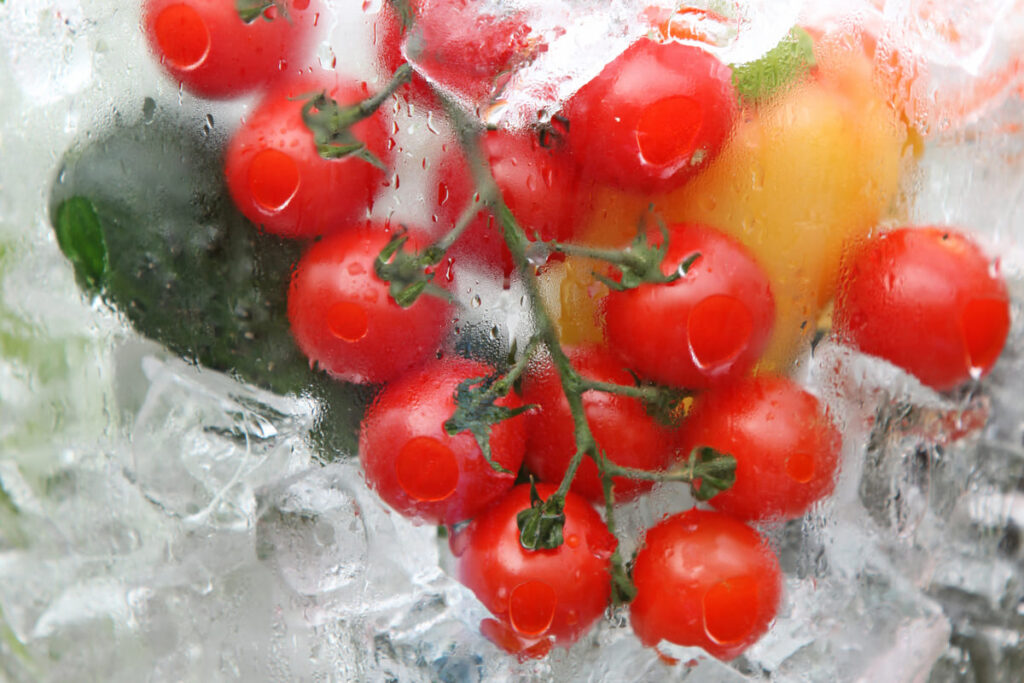Picture this: you’re in the midst of a bustling market, surrounded by vibrant fruits and vegetables that appear fresh and delicious. Ever wondered why they still look so appetizing? The answer lies in the question, “Why is Tube Ice Better for Preserving Vegetables and Fruits?”
Ice plays a crucial role in food preservation, maintaining freshness through ice storage techniques while preventing spoilage with proper temperature management. In today’s world of innovative temperature management methods, super-cooling, and super-chilling applications are employed to extend shelf life and preserve fruit quality.

The secret weapon here is tube ice – an often overlooked but highly effective form of ice that outperforms regular ice cubes when it comes to preserving vegetables and fruits. But why is tube ice better for preserving vegetables and fruits?
In our upcoming blog post, we’ll delve into the benefits of tube ice over other forms of ice, discuss concerns about biofilm formation on produce surfaces, explore prevention measures to ensure safe consumption,
The Importance of Ice in Food Preservation
Let’s talk about ice, baby.
Ice plays an integral role in preserving perishable foods such as seafood, dairy products, vegetables, and fruits.
Maintaining freshness with proper ice storage techniques can make all the difference between a delightful meal and an unfortunate case of food poisoning.
Different types of produce require different temperature management strategies to stay fresh and delicious – but don’t worry. We’ve got you covered.
Maintaining Freshness with Ice Storage Techniques
You might be wondering: how does one use ice effectively for preserving fruits and veggies?
The key lies in understanding that not all produce has the same ideal storage temperature.
- Tropical Fruits: These prefer temperatures around 50°F (10°C) – think mangoes or avocados.
- Citrus Fruits: They love slightly cooler temps at around 45°F (7°C).
- Veggies: Most vegetables thrive at just above freezing point – so keep them close to your ice cubes.
Ideal Temperature Management for Different Types of Produce

To ensure optimal freshness while avoiding spoilage or frost damage, pay attention to the temperature of your ice storage.
Stay cold, my friends.
Avoid stacking produce too close together to allow for proper air circulation and maintain a consistent temperature throughout your storage area.
Remember: keeping food safe is just as important as keeping it fresh.
To sum up, using ice wisely can make all the difference in preserving the quality and taste of fruits and vegetables – so don’t underestimate its power.
Advanced Temperature Management Techniques
Alright, let’s dive in. Researchers have been working diligently to create innovative approaches for keeping fruits and veggies fresh and of high quality. These methods focus on utilizing narrow sub-zero temperature zones for optimal food preservation. Let me break down two promising techniques: super-cooling and super-chilling.
Super-cooling Methods for Extended Shelf Life
Step #1: Super-cooling is a process that involves lowering the temperature of produce just below its freezing point without actually freezing it. This technique allows fruits and veggies to retain their texture, taste, and nutritional value while extending their shelf life significantly longer than regular ice storage methods can achieve.
Super-chilling Techniques Preventing Nutrient Loss
Step #2: Super-chilling takes things up a notch by rapidly cooling produce to temperatures slightly above its freezing point using special equipment like tube ice machines from Hiceay. The result? A longer-lasting product with minimal nutrient loss compared to traditional preservation methods involving ice cubes or regular ice storage systems.
Applications Across Multiple Industries Using Tube Ice Technology
Taking advantage of these advanced temperature management techniques isn’t limited to just one industry. The applications include fishery, seafood distributors, chilled and frozen meat importers and exporters, food processing plant,s and so on.
Why Tube Ice is Better for Preserving Vegetables and Fruits
Hey there, fellow foodies. Today, we’re going to dive into the world of tube ice and its role in preserving vegetables and fruits.
Have you ever wondered why tube ice is the superhero of preservation? Well, wonder no more. Let me break it down for you.
Addressing Biofilm Formation Concerns
Let’s tackle the issue of biofilm formation head-on.
This pesky issue can cause unpleasant odors or flavors within stored foods but don’t worry. We’ve got some modern solutions to minimize these risks and keep your produce safe to eat.
Modern Solutions to Minimize Biofilm Risks
Today’s ice machine manufacturers have our backs. They’ve engineered units specifically designed for minimizing biofilm formation while making it easy to remove when necessary. Hiceay, for example, offers top-notch tube ice machines that help maintain food quality without compromising safety standards.
Proper Cleaning Protocols Ensuring Safe-to-Eat Produce
Cleaning is key. To ensure your fruits and veggies stay fresh and free from contamination, follow a strict cleaning regimen with your ice machine.
Bonus Tip: Avoid Cross-contamination of Ice Cubes & Regular Ice
It’s also essential to avoid cross-contamination between different types of ice used in food preservation. Keep those regular ol’ ice cubes away from the fancy tube ice. This will ensure that each type of produce stays cold at its ideal temperature range.
New Technology Advancements in Ice Machines
Let’s not forget about the latest advancements in ice machine technology. These innovations help prevent biofilm formation and ensure that your produce stays fresh from storage to consumption.
Routine Microbiologic Sampling for Safety Assurance
What’s cooler than being cool? Staying safe. A routine microbiologic sampling of stored products is essential to keep food quality at its peak.
Avoiding Potential Contamination Risks While Traveling
Travelers take note.
Stay informed and enjoy those fruits and veggies without worry.
New Technology Advancements in Ice Machines
Alright, let’s dive into the icy world of innovation.
Today’s advanced tube ice machines are designed to keep your fruits and veggies fresh while minimizing biofilm formation.
You might be wondering, “How do they achieve this magic?”
Step #1: By implementing routine microbiologic sampling, manufacturers ensure that stored products remain safe for consumption.
Note: This is a game-changer when it comes to preserving freshness and quality.
Step #2: When traveling abroad, avoid drinking beverages with potentially contaminated ice from less-developed countries.
A little caution goes a long way in keeping you healthy.
Routine Microbiologic Sampling for Safety Assurance
Meticulous monitoring helps maintain optimal preservation conditions throughout the entire process – from storage to consumption.
- The first step involves regular testing of both the water supply and produced ice for any signs of contamination or harmful microorganisms.
- If detected early enough, corrective measures can be taken before spoilage occurs – ensuring only high-quality produce reaches consumers’ plates.
- This proactive approach reduces waste while safeguarding public health.
Avoiding Potential Contamination Risks While Traveling
- Beware. Not all places have stringent safety protocols in place.
- When traveling to less-developed countries, it’s wise to avoid consuming ice cubes or regular ice that may have been made using contaminated water sources.
- Instead, opt for bottled beverages and steer clear of those tempting but potentially hazardous frozen treats.
In a nutshell, advanced tube ice machines are revolutionizing the way we preserve our fruits and vegetables by ensuring they stay cold while minimizing biofilm formation risks. So next time you’re enjoying fresh produce or sipping on an icy beverage, remember – there’s some cool technology behind it all.
Advanced tube ice machines are designed to preserve fruits and vegetables while minimizing biofilm formation. Manufacturers implement routine microbiologic sampling to ensure stored products remain safe for consumption, reducing waste and safeguarding public health. When traveling abroad, it’s wise to avoid consuming potentially contaminated ice cubes or regular ice made using contaminated water sources.
FAQs in Relation to Why is Tube Ice Better for Preserving Vegetables and Fruits?
Why is Tube Ice Better for Preserving Vegetables and Fruits?
When it comes to preserving fruits and vegetables, tube ice is a better option than regular ice cubes. Tube ice is cylindrical in shape and has a smaller surface area than regular ice cubes. This means that it melts slower and stays cold for longer periods, making it ideal for use in food preservation.
Tube ice is also made with purified water, ensuring that it is free from impurities that can affect the quality of the food being preserved. Its shape also allows for better air circulation, which helps maintain the freshness of the produce.
For those in the food industry, such as fishery, seafood distributors, chilled and frozen meat importers and exporters, and food processing plants, tube ice is a reliable and cost-effective solution for preserving perishable items.
What is the importance of ice in food?
Ice plays a crucial role in preserving food, particularly perishable items like fruits, vegetables, and seafood. It helps maintain freshness by slowing down enzymatic reactions and microbial growth that cause spoilage. Ice also provides temperature control during transportation to ensure the quality and safety of products.
Are ice makers hygienic?
Yes, modern ice makers are designed with hygiene in mind. They often feature stainless steel components and self-cleaning functions to prevent contamination. However, proper maintenance and cleaning routines are essential for ensuring optimal sanitation levels in any ice-making equipment.
How did Egyptians make ice?
Ancient Egyptians made ice using evaporative cooling techniques. They would dig shallow pits or use pottery containers filled with water at night when temperatures dropped significantly. The water would lose heat through evaporation under the clear desert sky, eventually freezing into thin layers of ice which could be collected early morning before melting.
What is Jelly Ice made of?
Jelly Ice is a type of gel-like substance used as an alternative to traditional solid forms of frozen water for certain applications such as cold packs or shipping perishable items requiring constant low temperatures without direct contact with wetness from melting regular ice. #
Conclusion
In conclusion, proper temperature management is crucial in preserving the freshness and quality of fruits and vegetables. As an alternative to other forms of ice, tube ice has demonstrated its capacity for prolonged temperature control and thus serves as a superior option in food preservation. Additionally, advancements in technology have ensured high-quality preservation through improved tube ice machines and routine microbiological sampling.
Overall, choosing tube ice for food preservation can lead to better shelf life, reduced spoilage, and increased profitability for businesses in the food industry. To learn more about how HiceAy can help with your tube ice needs, contact us today.



